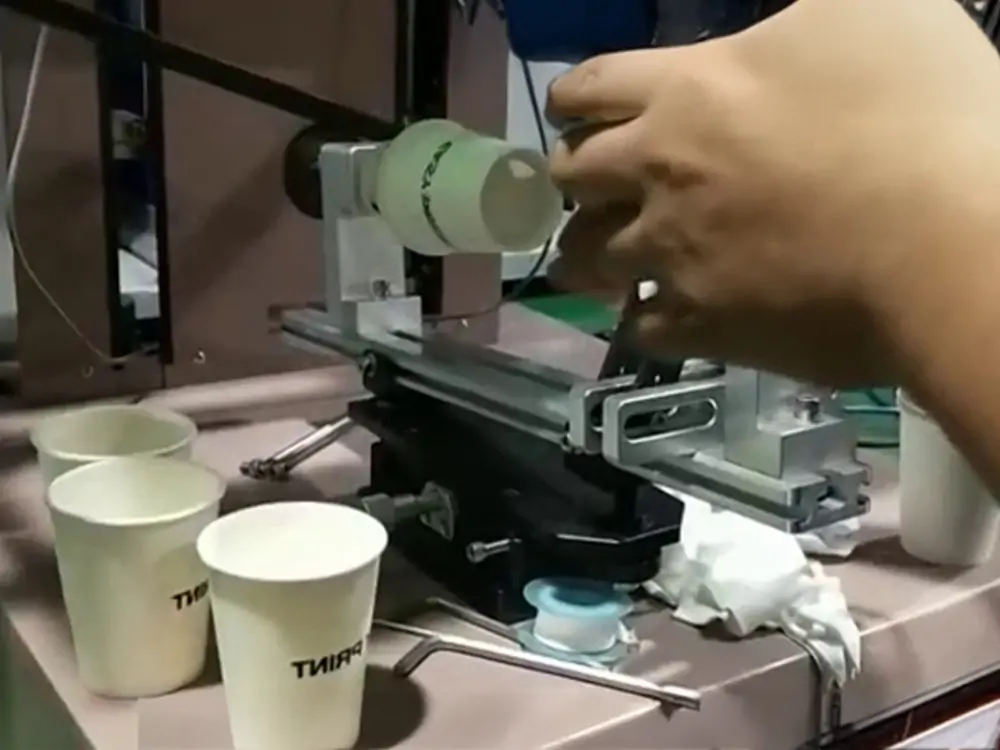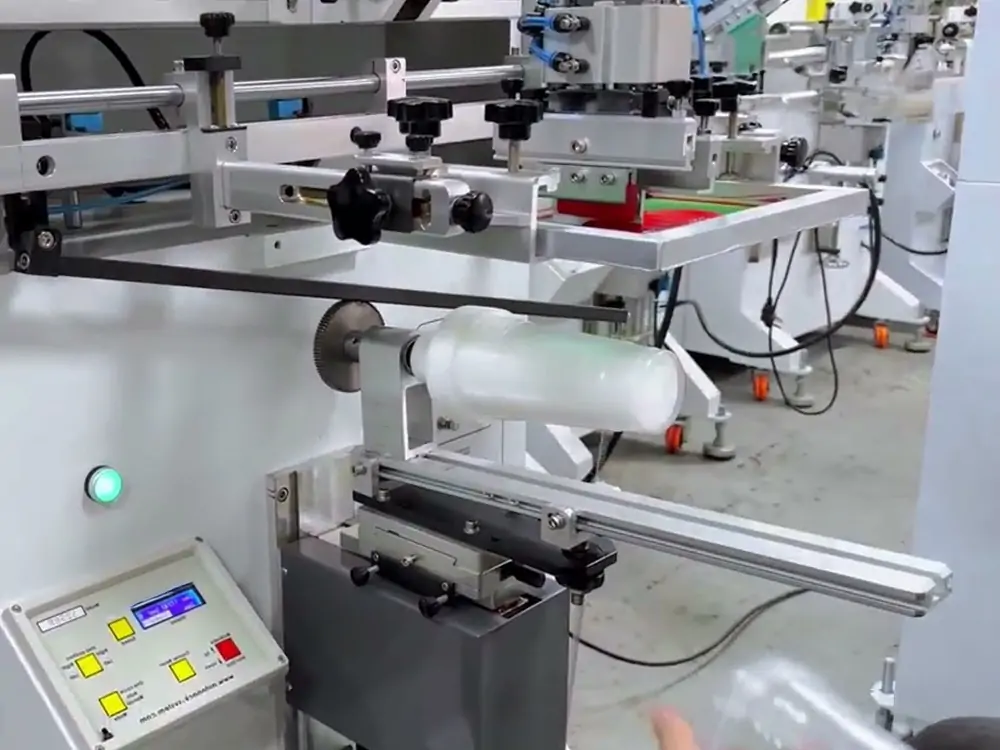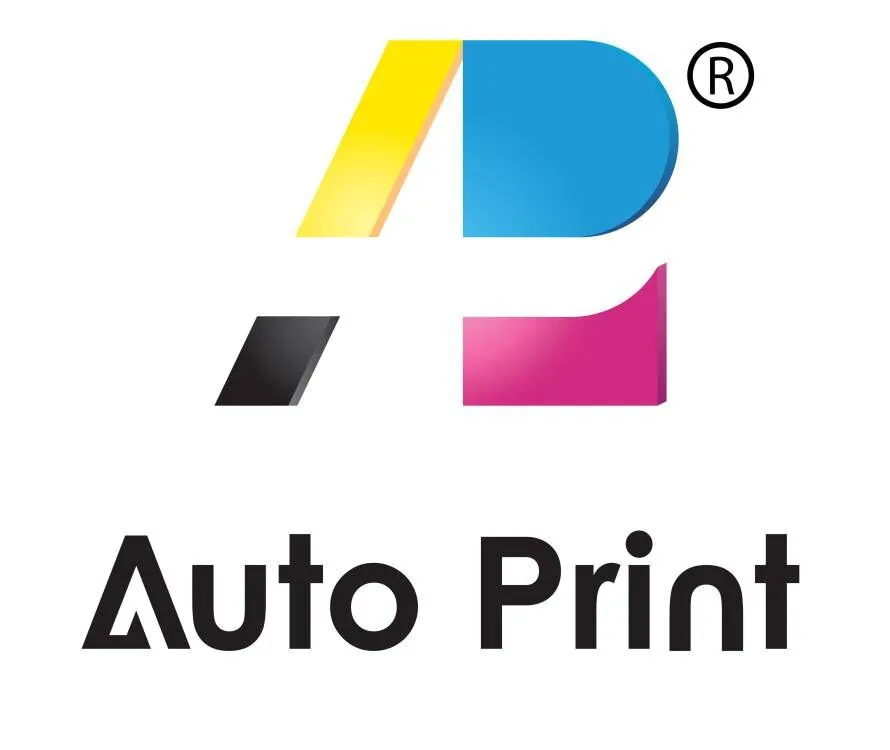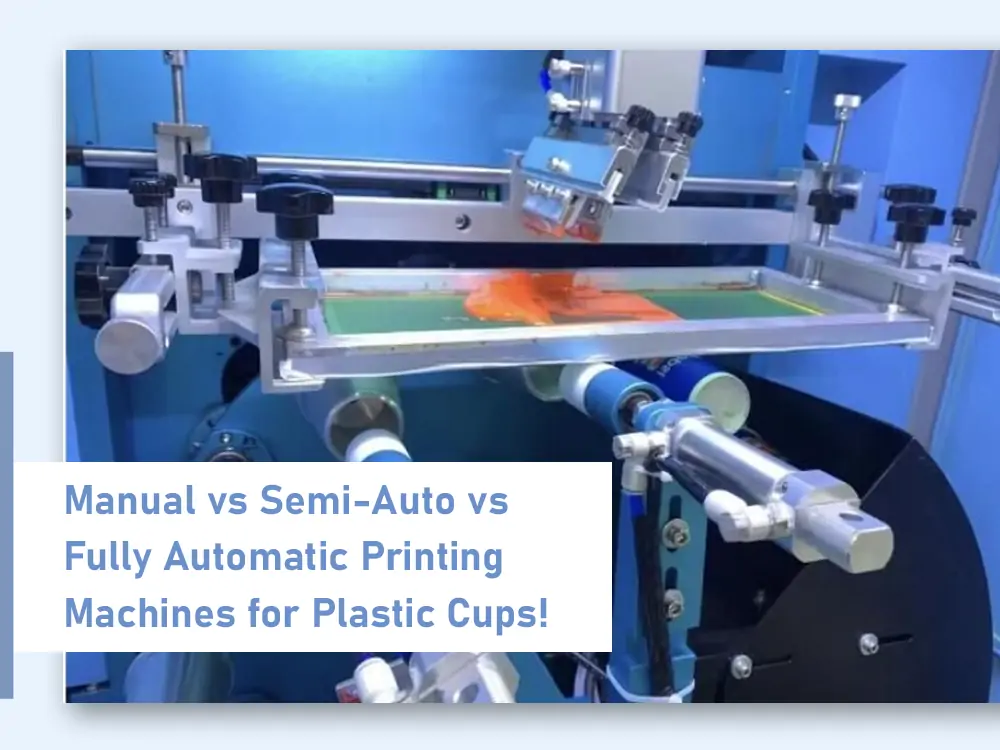You must have seen colorful plastic cups with beautiful designs. Have you ever wondered how those designs are printed so perfectly? The answer lies in the plastic cup printing machine. Interestingly, this machine is not just one kind; it comes in three types. That’s where a debate begins: manual vs semi-auto vs fully automatic printing machines for plastic cups.
Each of these machines works differently and offers unique features. Also, their suitability varies with business size and needs. That’s why knowing their key difference is crucial to choosing the right machine for your business. Feeling confused about which machine to go for? Worry not! This guide will make everything easy for you by comparing all three types. Let’s get started!
수동, 반자동 및 전자동 컵 인쇄기 개요
Before proceeding to the types, let’s first understand what a cup printing machine is!
컵 인쇄기는 다채로운 디자인을 컵 표면에 직접 인쇄하는 특수 장치입니다. 이 기계는 특수 기술을 사용하여 로고나 이미지와 같은 디자인을 인쇄합니다. 여기에는 UV 인쇄, 스크린 인쇄 또는 패드 인쇄가 포함됩니다. 이렇게 하면 스티커가 필요 없고 컵이 더욱 매력적으로 보입니다.

앞서 말씀드렸듯이 플라스틱 컵 인쇄기 세 가지 유형이 있습니다. 첫 번째는 수동 인쇄기입니다. 이것은 사람의 상호 작용으로 작동하는 간단한 유형입니다. 사람이 인쇄 프로세스의 모든 단계를 처리합니다. 예를 들어 작업자가 컵을 놓고, 인쇄물을 정렬하고, 잉크를 바르고, 제거합니다. 이 기계의 어떤 부분도 자동으로 작동하지 않습니다.
두 번째 유형은 반자동 인쇄기입니다. 수동 기술과 완전 자동 기술이 혼합된 형태입니다. 따라서 일부 작업은 기계가 수행하지만 다른 작업은 여전히 사람의 입력이 필요합니다. 예를 들어, 기계는 자동으로 디자인을 인쇄하고 잉크를 처리합니다. 하지만 컵을 넣고 빼는 작업은 사람의 손길이 필요합니다.
세 번째는 전자동 인쇄기입니다. 이름에서 알 수 있듯이 이 하이엔드 기계는 모든 작업을 수행합니다. 사람의 개입이 없기 때문에 더 정확하고 효율적입니다. 예를 들어 빈 컵 더미를 기계에 넣습니다. 그런 다음 컵을 골라 정렬하고 인쇄하고 건조시킨 후 제거합니다.
플라스틱 컵용 수동, 반자동, 전자동 인쇄기 비교: 주요 차이점
I hope the overview gave you a basic understanding of all three types of cup printing machines. Remember, each machine has its pros and cons. So, to understand them completely, let’s compare them head to head to decide which suits your project!
1- 자동화 수준 및 운영 속도

자동화 수준은 사람이 필요 없이 기계가 스스로 작동하는 방식을 의미합니다. 수동 컵 인쇄기는 자동화 수준이 가장 낮습니다. 모든 것이 수작업으로 이루어집니다. 컵을 놓고, 인쇄를 시작하고, 인쇄 후 컵을 제거해야 합니다. 이 모든 과정이 전체 인쇄 작업의 속도를 떨어뜨립니다.
그러나 반자동 컵 인쇄기는 중간 수준의 자동화 기능을 갖추고 있습니다. 이 기계는 일부 작업을 스스로 수행할 수 있습니다. 예를 들어, 디자인을 인쇄하고 잉크를 자동으로 건조시킵니다. 하지만 일부 작업의 경우 여전히 사람이 직접 이 과정에 참여해야 합니다. 이로 인해 인쇄 프로세스는 어느 정도 빨라지지만 여전히 시간이 걸립니다.
마지막으로 완전 자동화된 인쇄기입니다. 이 기계는 최고 수준의 자동화 기능을 갖추고 있습니다. 컵 로딩부터 인쇄, 제거까지 모든 작업이 기계에 의해 수행됩니다. 따라서 이러한 기계는 짧은 시간에 많은 컵을 인쇄할 수 있습니다. 결과적으로 인쇄 작업이 매우 빠르고 효율적으로 이루어집니다.
2- 노동 요구 사항 및 유지 관리 요구 사항
컵 인쇄기 유지보수 는 근본적이고 중요한 차이점을 이해해야 합니다. 예를 들어 수동 컵 인쇄기는 간단하고 부품이 단순합니다. 복잡한 전자 장치나 센서가 포함되어 있지 않아 유지보수가 용이합니다. 하지만 수동 기계는 노동력이 많이 필요합니다.
인쇄의 각 단계는 수작업으로 이루어져야 합니다. 따라서 이러한 기계에는 많은 노동력이 필요합니다. 반대로 반자동 기계는 일부 단계를 자동화하여 물리적 작업량을 줄여줍니다. 예를 들어, 이러한 기계는 잉크를 도포하고 컵을 회전시킵니다. 결과적으로 노동력이 적당히 필요합니다. 유지 보수와 관련하여 반자동 기계는 약간 복잡합니다.
여기에는 적절한 유지 관리가 필요한 모터, 스위치 및 제어판이 포함됩니다. 반면 전자동 인쇄기는 사람의 개입을 최소화하면서 작동합니다. 컵을 공급하고, 인쇄하고, 제거하는 거의 모든 작업이 자동으로 이루어집니다. 작업자는 일반적으로 모니터링과 품질 관리에만 필요합니다.
That’s why these machines require little to no labor. However, automatic machines are demanding in terms of maintenance. They involve advanced machinery features and electronic systems. Those parts require regular servicing, like lubrication, calibration, and software updates. All this needs professional maintenance to ensure quality.
3- 인쇄 품질 및 일관성
Print quality refers to how sharp and vibrant the printed design appears on the cup. Consistency indicates whether results stay the same across thousands of prints. Let’s first begin with manual cup printing machines. As I said above, these machines work with human involvement. So, the print quality depends heavily on the operator’s skill.
That’s why printing errors like smudges and uneven color are most likely to appear. Moreover, consistency is also harder to maintain, especially in long production runs. On the other hand, semi-auto machines perform better in this area. Automated components control some parts of the printing process. So there is better alignment and ink control.
따라서 수동 기계에 비해 더 균일한 인쇄가 가능합니다. 그러나 보시다시피 이 기계에는 여전히 몇 가지 수동 단계가 필요합니다. 따라서 정렬 불량으로 인해 디자인에 약간의 차이가 발생할 수 있습니다. 이제 완전 자동 인쇄기를 살펴보면 이 용어에서 매우 효율적입니다. 이 기계는 자동화 수준이 가장 높습니다.
인적 오류의 가능성이 없으므로 품질이 향상됩니다. 이 기계는 모든 컵이 동일한 속도, 압력 및 정렬로 인쇄되도록 보장합니다. 따라서 천 번째 컵도 품질과 인쇄물 측면에서 첫 번째 컵과 똑같아 보입니다. 자동 기계를 사용하면 대규모로 전문가 수준의 고품질 인쇄물을 얻을 수 있습니다.
4- 생산량 역량
생산량은 기계가 특정 시간에 인쇄할 수 있는 컵의 수를 나타냅니다. 이 세 가지 기계는 모두 이 점에서 다르게 작동합니다. 먼저 수동 컵 인쇄기에 대해 설명하겠습니다. 아시다시피 이 기계는 사람의 수작업에 의존하기 때문에 전체 공정이 느립니다. 따라서 소규모 맞춤 주문에 이상적입니다.
On the flip side, semi-auto machines are fast. Some parts are automated and don’t need human involvement. Operators only need to manage a few tasks, like loading and unloading. This improves the production capacity to some extent. Hence, these machines are designed to produce medium-volume printed cups.
이와는 대조적으로 전자동 인쇄기는 완전히 자동화된 기계입니다. 이러한 기계는 사람의 개입 없이 지속적으로 작동하며 모든 작업을 처리합니다. 따라서 많은 양의 컵을 순식간에 인쇄할 수 있습니다. 이러한 빠른 속도는 대량 생산의 요구를 충족하는 데 이상적입니다. 일일 주문량이 많은 회사에 적합합니다.
5- 사용 편의성 및 교육

Another difference between these three cup printing machines is how easy they are to use. Let’s first discuss the manual cup printing machine. This machine is generally the simplest to understand and operate. It has fewer buttons, no digital control, and straightforward mechanical steps. So, anyone with basic instructions can learn how to use it.
하지만 고품질의 결과를 얻으려면 더 많은 연습이 필요합니다. 예를 들어 컵을 올바르게 정렬하고 압력을 가하려면 경험이 필요합니다. 반면에 반자동 인쇄기는 조금 더 복잡합니다. 여기에는 모터 구동식 움직임과 같은 일부 자동화된 기능이 포함되어 있습니다.
So, you have to learn how to operate the control panel and adjust settings to avoid errors. While it’s not very difficult to operate, little training and hands-on practice are crucial. Once you learn the basics, it will be far easier to manage later. Now, if we discuss fully automatic printing machines, they are very complex.
이러한 기계에는 디지털 제어, 센서 및 프로그래밍 가능한 설정이 포함됩니다. 따라서 이러한 시스템을 이해하려면 더 많은 기술 지식이 필요합니다. 멀티 컬러 인쇄 및 터치스크린과 같은 기능을 작동하려면 연습과 교육이 필요합니다. 하지만 일단 교육을 받으면 기계는 효율적이고 쉽게 사용할 수 있습니다.
6- 공간 및 설정 요구 사항
Space and setup requirements also differ for each type of cup printing machine. For example, manual machines are the most compact of all. They usually have small frames and don’t require additional equipment. Moreover, their setup is also simple, involving just a power source. It means you can easily adjust them in small places.
반대로 반자동 기계는 더 크고 더 많은 부품을 포함합니다. 예를 들어, 이러한 기계에는 제어 패널, 자동화 부품, 모터가 포함됩니다. 또한 일부 기능에는 수동 개입이 필요합니다. 따라서 작업자가 자유롭게 작업하고 이동할 수 있는 전용 공간도 필요합니다. 그러나 이러한 기계 설정은 중간 규모의 공장에서 관리할 수 있습니다.
전자동 인쇄기는 가장 크고 복잡한 기계입니다. 이러한 기계에는 피더, 건조기, 컨베이어 및 제어 시스템이 포함됩니다. 크기가 크고 자동화되어 있기 때문에 많은 바닥 공간이 필요합니다. 또한 설치 시 전문적인 설치와 시스템 보정이 필요합니다. 따라서 이러한 기계는 대규모 제조 시설에 이상적입니다.
7- 비즈니스 유형에 대한 적합성
각 유형의 인쇄기는 각기 다른 종류의 비즈니스에 가장 적합합니다. 예를 들어 수동 인쇄기는 소규모 비즈니스와 스타트업에 이상적입니다. 소량으로 컵 생산을 시작하는 경우 수동 기계가 적합합니다. 어떻게? 큰 공간이나 많은 인력이 필요하지 않습니다. 또한 유연성이 필요한 작업에도 적합합니다.
반면에 반자동 기계는 성장하는 비즈니스에 적합합니다. 산업 환경에 뛰어들지 않고 생산량을 늘려야 하는 비즈니스에 적합합니다. 이 기계는 수동 제어와 자동화 제어 사이의 완벽한 균형을 이룹니다. 따라서 중간 정도에서 높은 수요를 가진 중견 기업에 이상적입니다.
반면, 전자동 기계는 대규모의 컵 인쇄 사업. 이 기계는 속도가 빠르고 효율적입니다. 따라서 짧은 시간에 수천 개의 컵을 인쇄할 수 있습니다. 따라서 촉박한 마감일과 많은 주문량을 맞추는 데 도움이 됩니다. 따라서 전반적으로 자동 인쇄기는 대량 제조 회사에 적합합니다.
8- 비용 및 경제성

Cost is one of the significant factors that differentiate cup printing machines. Each type of machine has a different price range. For example, manual printing machines are a cost-effective option with low running expenses. WHY? First, they involve simple parts that come at lower prices. Moreover, these machines don’t require skilled staff.
This eliminates the need for labor. Lastly, manual machines also require less maintenance. They don’t wear out quickly and last long, reducing their cost. On the flip side, semi-auto machines are moderately priced. They are more expensive than manual machines due to partially automated features. This also increases the cost of maintenance and labor to some extent.
마지막으로, 전자동 인쇄기는 다른 모든 인쇄기보다 더 비쌉니다. 첫 번째 이유는 첨단 기술과 자동 시스템 때문입니다. 이러한 시스템을 운영하려면 숙련된 직원을 고용하고 적절한 교육을 받아야 합니다. 또한 이러한 기계는 정기적인 유지보수가 필요하기 때문에 비용이 더욱 증가합니다. 그러나 장기적으로 볼 때 이러한 기계는 생산 속도가 빠르기 때문에 비용 효율성이 매우 높습니다.
수동, 반자동, 완전 자동 중 어떤 인쇄기를 선택해야 하나요?
이 질문에 대한 정답은 없습니다. 프로젝트의 요구 사항에 따라 크게 달라집니다. 그래서
Manual printing is the best choice if you’re new to the cup printing business. Semi-auto machines are ideal if your business is growing and you need cost-effective yet fast production. But if your business requires mass production with high speed and accuracy, I recommend fully automated machines.
하지만 만능 기계는 없다는 사실을 기억하세요. 각기 장단점이 있습니다. 따라서 최종 선택을 위해서는 비즈니스의 특성을 이해해야 합니다. 예를 들어 수동 컵 인쇄기는 간단하고 작동하기 쉽습니다. 숙련된 작업자를 고용하지 않고도 운영할 수 있습니다. 그러나 이러한 기계는 더 많은 육체적 노력이 필요하므로 대량 주문에는 적합하지 않습니다.
그러나 반자동 인쇄기는 수동 인쇄기보다 앞서 있습니다. 속도가 더 빠르며 수작업이 덜 필요합니다. 또한 이러한 기계는 저렴하고 유지 관리도 비교적 쉽습니다. 따라서 이러한 기계는 이전보다 더 많은 컵이 필요한 중간 규모 비즈니스에 적합합니다. 그러나 일부 단계에서는 반자동 머신도 여전히 사람의 개입이 필요합니다.
완전 자동화된 기계는 대규모 생산을 위해 설계되었습니다. 모든 부품이 자동으로 작동하고 사람의 개입이 필요하지 않으므로 매우 빠르고 정확합니다. 이러한 기계는 순식간에 수천 개의 컵을 만들 수 있습니다. 그러나 이러한 기계는 초기에는 비용이 많이 들지만 장기적으로는 비용 효율성이 높습니다.
자주 묻는 질문
초보자에게 가장 적합한 머신은 무엇인가요?
수동 컵 인쇄기는 초보자에게 가장 적합합니다. 복잡한 기계 부품이 필요하지 않습니다. 따라서 기본 설명서만 있으면 효율적으로 작동할 수 있습니다.
이러한 기계의 예비 부품을 쉽게 구할 수 있나요?
예, 이러한 기계의 예비 부품을 사용할 수 있습니다. 이는 상당한 이점입니다. 부품이 마모된 경우 신뢰할 수 있는 곳에서 부품을 구입할 수 있습니다. 인쇄 기계 제조업체.
컵 인쇄에는 어떤 종류의 잉크가 사용되나요?
컵 인쇄에 사용되는 잉크의 종류는 인쇄 방법에 따라 다릅니다. 표준 인쇄 잉크에는 다음이 포함됩니다.
- UV 잉크
- 식품 등급 잉크
- 솔벤트 기반 잉크
결론
맞춤 제작 컵은 경쟁이 치열한 세상에서 브랜딩과 마케팅을 위해 인기를 끌고 있습니다. 하지만 잘 디자인된 모든 플라스틱 컵 뒤에는 적합한 기계가 있습니다. 이러한 기계는 크게 세 가지 유형으로 나뉩니다. 컵 인쇄 비즈니스의 초보자라면 기본 사항과 차이점을 이해하는 것이 중요합니다. 이 글에서는 각 기계 유형에 대한 모든 것을 살펴보았습니다.
예를 들어 수동 인쇄기는 간단하고 작동하기 쉽습니다. 소규모 비즈니스에 가장 적합합니다. 그러나 반자동 기계는 약간의 버전입니다. 이러한 기계의 일부는 자동으로 작동하지만 일부는 사람의 개입이 필요합니다. 마지막으로 전자동 기계는 고도로 발전되고 효율적입니다. 속도가 빠르고 정확하며 대규모 생산에 가장 적합합니다.

